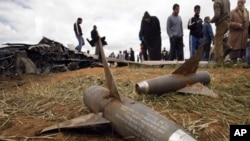A U.N.-backed coalition is increasing its efforts to expand a no-fly zone over Libya and halt attacks on civilians by troops loyal to Moammar Gadhafi. Robert Raffaele has the details.
Anti-aircraft fire rings out over the capital, Tripoli, as forces loyal to Libyan leader Moammar Gadhafi try to ward off coalition airstrikes.
But there is no let up in the U.N.-backed mission, with British, French, U.S. and Dutch warplanes taking off from Italian soil, and plans in place to expand the coalition to 13 nations. The aim is to control the airspace across northern Libya. Left unclear - who will take charge after the U.S military relinquishes operational control.
Britain and Italy want NATO in command. France favors a committee of coalition nations and Arab partners.
The U.S. State Department downplayed the split. Acting deputy spokesman Mark Toner:
"Again, I would just say that we believe discussions are ongoing at NATO to address some of these concerns and I don't want to prejudge those conversations - just to say that what we've said previously, which is that NATO has certain command and control capabilities that are useful," said Toner.
Meanwhile, America's military role in Libya faces objections among U.S. lawmakers. Some object to President Barack Obama's ordering military action without congressional consent. Others, the added cost of involvement in another war.
Analyst Graeme Bannerman, with the Middle East Institute, says such criticism could affect Mr. Obama's legislative efforts.
"They point out that under the [US] constitution, the American forces are not supposed to be used unless authorized through a declaration of war by Congress, and funded by Congress and this process has skipped the whole constitutional aspect of it," said Bannerman. "They point out that the [Obama] administration took the time to go get a U.N. resolution, but never bothered to address this with Congress."
The coalition air campaign suffered its first loss late Monday, with the crash of an American warplane in Libya. The U.S. Navy says both crewmembers ejected safely, after the aircraft encountered mechanical problems.











